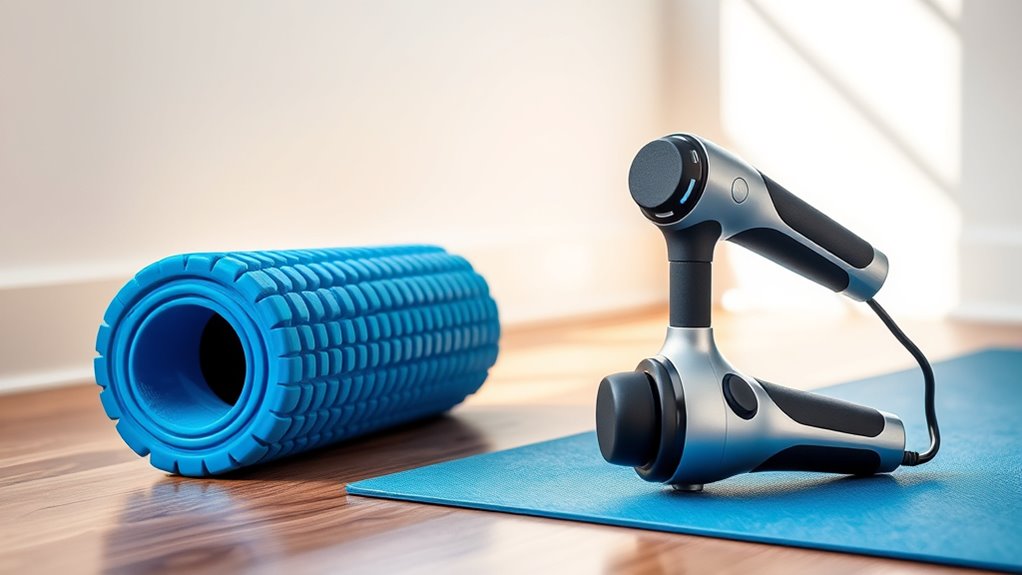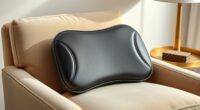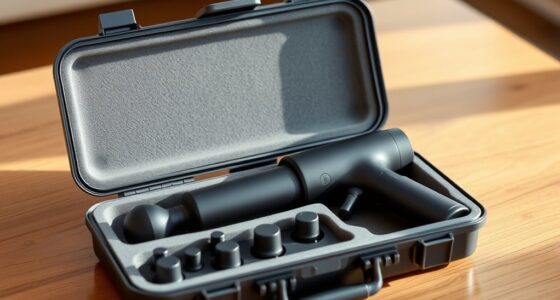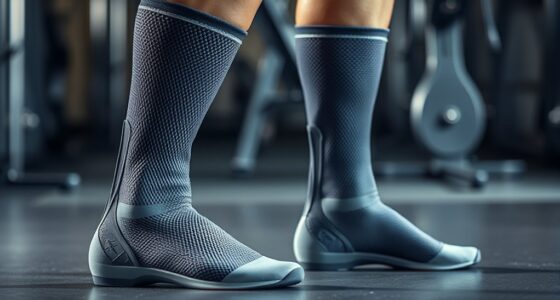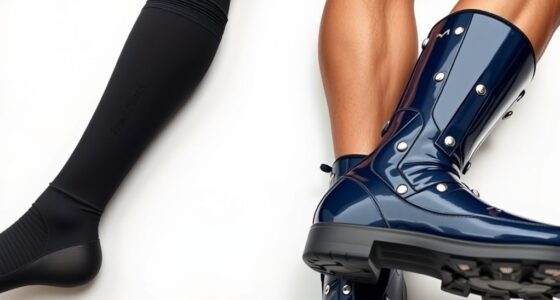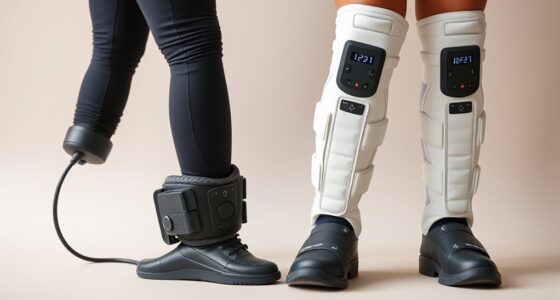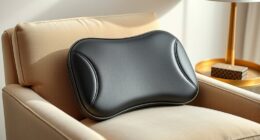If you’re looking to recover faster, both foam rolling and percussive massage can help, but they serve different purposes. Foam rolling is great for improving flexibility, releasing fascia, and warming up muscles, making it ideal before activity. Percussive massage targets deep muscle tissue, providing quick relief from knots and tension, which speeds recovery afterward. For best results, combining both methods tailored to your needs can optimize your muscle health—stick around to find out how each technique works best for you.
Key Takeaways
- Percussive massage penetrates deeper and provides faster relief of muscle knots compared to foam rolling.
- Foam rolling improves flexibility and tissue elasticity, aiding long-term recovery.
- Combining both methods offers comprehensive muscle recovery and injury prevention benefits.
- Percussive massage delivers targeted, adjustable pressure for immediate deep tissue relief.
- Foam rolling is more accessible and enhances flexibility, supporting quicker overall recovery.
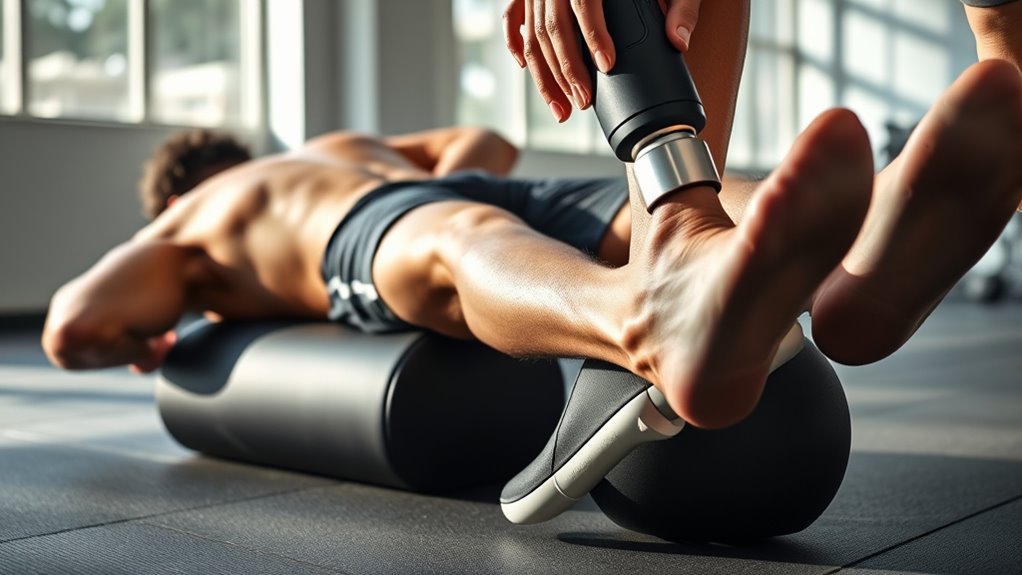
When it comes to muscle recovery and relief, foam rolling and percussive massage are popular options, but understanding their differences can help you choose the best method for your needs. Both techniques target muscle tightness and soreness, but they do so in different ways, influencing factors like muscle flexibility and injury prevention. If your goal is to improve overall movement and reduce the risk of injury, knowing which method suits your needs can make a significant difference.
Foam rolling, also known as self-myofascial release, involves using a foam cylinder to apply pressure to specific muscle areas. When you roll over tight or tender spots, you help break up adhesions in your fascia—the connective tissue surrounding muscles—which enhances muscle flexibility. Better flexibility not only makes your movements smoother but also decreases the likelihood of strains and other injuries. Foam rolling is accessible, cost-effective, and easy to incorporate into your routine, making it a popular choice among athletes and fitness enthusiasts. However, it requires some patience and technique to target muscles effectively without causing discomfort.
Foam rolling enhances flexibility and prevents injuries through self-myofascial release.
Percussive massage devices, on the other hand, deliver rapid, targeted pulses deep into your muscles through mechanical percussion. This method is often used with handheld devices that can be applied directly to sore or tight areas. Percussive massage can penetrate deeper layers of muscle tissue more quickly than foam rolling, providing rapid relief from tension and soreness. Many users find it more comfortable because the device’s consistent pressure can be adjusted, reducing the risk of applying too much force. Because of its ability to access deeper tissues, percussive massage can be particularly effective for athletes with chronic tightness or those recovering from intense training sessions, supporting injury prevention by maintaining optimal muscle health.
While foam rolling is excellent for increasing muscle flexibility and preparing muscles for activity, percussive massage excels at targeting stubborn knots and deep tissue tightness. If you’re looking for a method to incorporate into a warm-up that boosts your range of motion and reduces injury risk, foam rolling is a great choice. For more targeted relief or to address specific areas of deep-seated tension, percussive massage might be more effective. Both methods, when used correctly, can complement each other, creating a extensive approach to muscle health and injury prevention. Ultimately, your choice depends on your specific needs, preferences, and the areas you want to treat.
Frequently Asked Questions
Can Foam Rolling and Percussive Massage Prevent Injuries?
Yes, foam rolling and percussive massage can help prevent injuries by improving muscle flexibility and reducing tightness. When you regularly use these techniques, you promote better blood flow and tissue health, which lowers the risk of strains and overuse injuries. Incorporating them into your routine keeps muscles supple and resilient, making it less likely you’ll experience injuries during workouts or daily activities.
Are There Any Risks or Side Effects Associated With Each Method?
Both foam rolling and percussive massage can cause risks like muscle soreness or tissue damage if improperly used. You might experience temporary discomfort or bruising, especially with excessive pressure. To minimize side effects, follow proper techniques, avoid overdoing it, and listen to your body. If you notice persistent pain or tissue damage, stop immediately and consult a healthcare professional to prevent long-term issues.
How Long Should Each Recovery Technique Be Applied?
Think of recovery techniques as tuning a guitar—timing matters. For foam rolling, aim for 1-2 minutes per muscle group, focusing on slow, controlled application techniques. Percussive massage can be applied for 1-2 minutes per area, using steady, rhythmic strokes. Always listen to your body, avoid overdoing it, and follow duration guidelines to prevent irritation. Proper timing helps your muscles recover without turning a simple tune into discord.
Is One Method More Effective for Specific Muscle Groups?
You’ll find that foam rolling is especially effective for larger muscle groups like the quads and hamstrings, thanks to its muscle specificity and ability to cover broad areas. Percussive massage, on the other hand, works best for targeted muscles such as the calves or shoulders, providing deep tissue relief. Choose based on your muscle group needs, as each technique’s effectiveness varies with muscle size and depth.
Can Combining Both Methods Enhance Recovery Outcomes?
Combining foam rolling and percussive massage can markedly improve your recovery. Studies show that using both methods enhances muscle flexibility and increases blood circulation more than either alone. By integrating these techniques, you stimulate different tissue layers, promoting faster healing and reducing soreness. You’ll experience better performance and quicker recovery, making your workouts more effective. Don’t settle for just one—using both maximizes your muscle recovery potential.
Conclusion
Both foam rolling and percussive massage can help speed up your recovery, but the choice depends on your needs. Notably, studies show that percussive therapy can reduce muscle soreness by up to 30% faster than foam rolling. So, whether you prefer the simplicity of foam rolling or the targeted relief of percussive massage, incorporating either into your routine can get you back to your peak faster. Pick what works best and keep moving forward!
